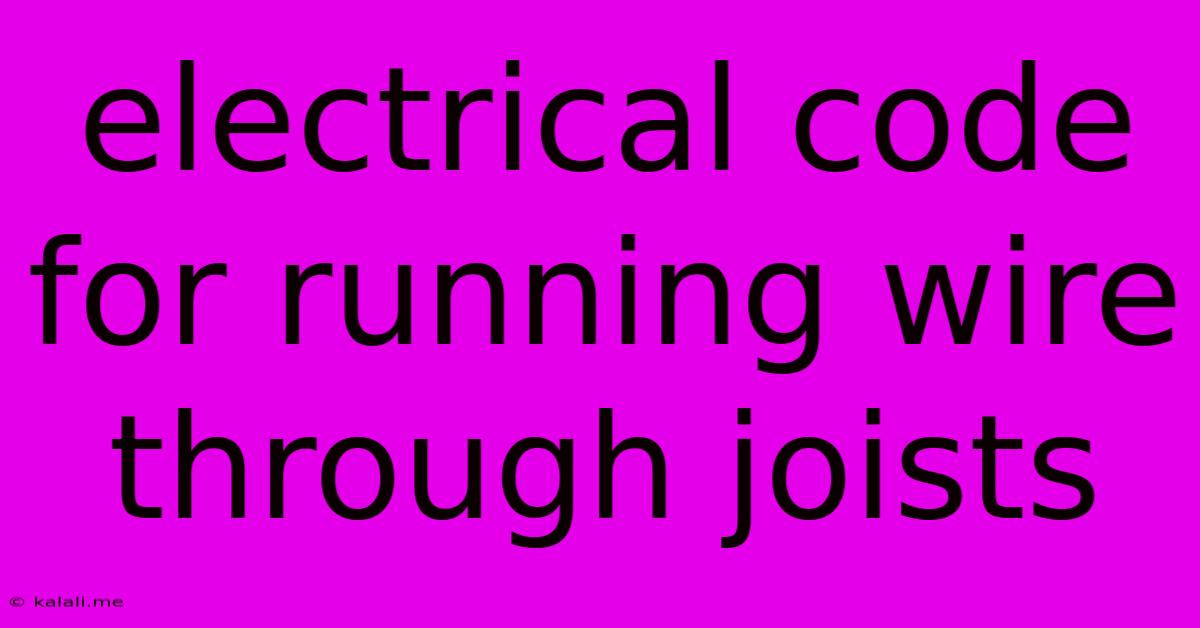Electrical Code For Running Wire Through Joists
Kalali
Jun 03, 2025 · 3 min read

Table of Contents
Navigating the Electrical Code Maze: Running Wire Through Joists Safely and Legally
This article provides a comprehensive guide to understanding and complying with electrical codes when running wires through joists, focusing on safety and adherence to regulations. Ignoring these codes can lead to fire hazards, electrical shocks, and costly repairs. Understanding the specifics will help you ensure your electrical work is up to code and protects your home and family.
Key Takeaways: This guide covers crucial aspects of routing electrical wiring through floor joists, including permitted methods, required safeguards, and common code violations to avoid. We'll discuss the importance of using the correct wire types, securing the wiring properly, and maintaining adequate clearance for safety.
Understanding the NEC and Local Codes
The National Electrical Code (NEC) provides the foundational guidelines for safe electrical installations in the United States. However, local jurisdictions often adopt and amend these codes, so it's crucial to consult your local building codes and permits before starting any electrical work. These codes often specify requirements for joist size, wire type, and installation methods.
Permissible Methods for Running Wire Through Joists
There are several approved methods for running electrical wires through joists, each with its own set of requirements:
-
Using approved cable clamps or straps: This is the most common and preferred method. These clamps are designed to secure the wire to the joist without damaging the insulation and provide a safe, secure pathway. Make sure the clamps are rated for the type and size of cable being used.
-
Running wire through pre-drilled holes: Holes should be drilled with care to avoid damaging the structural integrity of the joists. The holes must be adequately sized to accommodate the wire without causing excessive strain or damage. Smooth edges are crucial to prevent insulation abrasion.
-
Using approved raceways (conduits): Running wires inside metal or plastic conduits is another acceptable method. This provides additional protection for the wiring. Conduits should be properly secured to the joists to prevent movement and potential damage.
Crucial Considerations for Safe and Compliant Installation
-
Maintaining Minimum Clearance: Ensure sufficient clearance between the wire and any other materials within the joist cavity. This is crucial to prevent overheating and potential fire hazards.
-
Correct Wire Type Selection: Using the right type of wiring is paramount. Romex (NM-B) cable is commonly used for residential applications, but its suitability depends on several factors, including the location and environmental conditions. Always consult the NEC and local codes for the appropriate wire type for your specific application.
-
Proper Grounding: All wiring must be properly grounded to protect against electrical shocks. This involves ensuring the ground wire is connected to the grounding system of the house. This is a critical safety aspect that cannot be overlooked.
-
Avoiding Overloading Circuits: Each circuit has a specific amperage rating. Overloading a circuit by running too many wires through a single joist can lead to overheating and potential fire hazards.
-
Inspection and Permits: Before you begin any electrical work, it is highly advisable to consult a qualified electrician. Even with a thorough understanding of the codes, electrical work can be complex, and an experienced electrician can identify and address potential issues before they become problems.
Common Code Violations to Avoid
-
Using unapproved methods: Improper methods of running wires through joists can lead to serious hazards.
-
Failing to secure wires adequately: Loose wiring can damage insulation, create shorts, and potentially lead to fires.
-
Insufficient clearance around wires: Improper spacing can cause overheating.
-
Improper grounding: Lack of proper grounding is a significant safety risk.
-
Overloading circuits: This poses a serious fire hazard.
By carefully following the guidelines outlined above and consulting the relevant electrical codes, you can ensure a safe and compliant installation when running wires through joists. Remember, safety is paramount, and investing in a qualified electrician for any complex electrical work is a wise precaution. While this guide provides valuable information, it's not a replacement for professional advice and local code compliance.
Latest Posts
Latest Posts
-
Should I Clean My Web Sql Data
Jun 05, 2025
-
Change Door Knob Keep Same Key
Jun 05, 2025
-
Internet Turns Off When Mac Sleeps
Jun 05, 2025
-
Text Font That Goes Up And Down Small
Jun 05, 2025
-
Is It Difficult To Knock Down Stone Wall In House
Jun 05, 2025
Related Post
Thank you for visiting our website which covers about Electrical Code For Running Wire Through Joists . We hope the information provided has been useful to you. Feel free to contact us if you have any questions or need further assistance. See you next time and don't miss to bookmark.